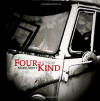Four of a Kind
Here are four reasons to read Mark Neely’s chapbook Four of A Kind, winner of the 2009 Concrete Wolf Chapbook Competition:
Here are four reasons to read Mark Neely’s chapbook Four of A Kind, winner of the 2009 Concrete Wolf Chapbook Competition:
1. The carefully constructed symmetry of the 16 poems, each consisting of four parts that together form a square.
2. The vividly detailed scenes in every single quarter of every poem. Observe that “The woman on the corner had perfect toenails,” and see “The violets on the bathroom wallpaper pucker.”
3. The attention paid to language by a poet who confesses he wants to be able to “say the name of everything.” Take the second quarter of “Four Names”:
Of all Hileni they thought themselves best—Heleni-wek, Illiniwek, Illinois. Trudged through head-high grass, raiding and retreating, shouting at the kids, shouting at the kids, Stay close, but still their names fell on the ground—Peoria, Kaskaskia, Cahokia—it welcomed them as it will welcome all of us one day. Gave way to Buckeyes, Hoosiers, Suckers, stepping like old soldiers in footprints of the dead.
4. The lingering power of similes constructed by a writer obsessed with connections. Here are a few: “My mother’s [father] honked in a handkerchief like a tugboat”; “Cornstalks walked the road like Russian refugees”; “Those locust trees could hiss like snakes.”
There is much more of merit here as well, including the playful yet controlled syntax and intriguing epigraphs that introduce such diverse figures as Freud, Sherlock Holmes, and Aeschylus. Yet perhaps most impressive is the dynamic interplay between the various parts of Four of A Kind. Neely asks us never to settle in any one place but instead to keep moving; to find out how things relate to one another. He drives ahead with insistent momentum (“Four Lanes,” “Four Journeys”), then forcefully draws us back into cycles (“Four Moons”) and into ourselves (“Four Mirrors”). In this way, he obliges us to consider how we make meaning, cobbling together elements of experience in pairs, in quarters, and in a balanced, multilayered whole.





